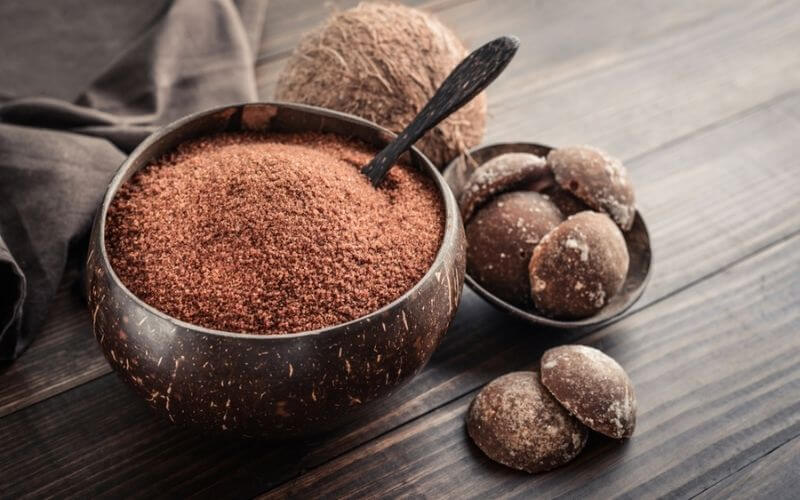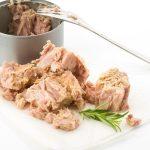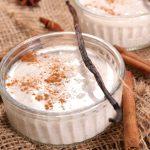If you’ve ever tried making Thai or Indian dishes, you may have noticed that palm sugar is a pretty important ingredient. And while you might have thought that swapping it for white sugar was a good option, it really isn’t a proper palm sugar substitute.
Palm sugar has certain characteristics that give it a unique flavor, making it almost indispensable in dishes like Pad Thai noodles, South Asian and Thai curries, and Indo-Malaysian cuisine. But since it can be a tricky ingredient to find, chances are you need to find a proper palm sugar alternative.
And that’s why I’m here to present you with 5 ingredients that you can use as a palm sugar alternative. They have a flavor profile pretty comparable to palm sugar, so you will be able to achieve similar results.
But that’s not all. You will also learn which of these ingredients work best for different dishes and cuisines, and the things that you should avoid them in as well. The article will also provide a rundown of the best products and where you can find them.
What is Palm Sugar?

Palm sugar is a kind of sweetener derived from the sap of palm trees. The sap is extracted from the coconut palms and then boiled and simmered until the excess water dries up and a thick, rich syrup is formed. This syrup is also sold for consumption, but most of the time is crystallized to form the more conventional version of palm sugar.
The palm sugar crystal is a warm brown and is sold in block or granular form. Because it isn’t treated with chemicals, it is a ‘natural’ sweetener and is rich in vitamins and minerals. Compared to the more processed white sugar, it is a borderline healthy choice of sweetener.
In terms of taste, palm sugar has a unique flavor, it has deep smoky notes and a hint of caramel. It also tastes a lot more complex and richer when compared to both brown and white sugar. This makes a great choice for adding great depth to many Thai and Malay sauces and curries. In South Asia, it is sometimes added to curries and dals.
The region of Bengal is well known for its love of palm sugar. Besides adding it to curries, palm sugar syrup and its granular form are added to countless traditional dessert dishes, eaten with Rotis, and are a staple in many kinds of rice pudding.
It is also added to chai, replacing white sugar to give it a smokier and richer flavor. In recent times, many innovative recipes use palm sugar syrup in ice creams, cakes, souffles, and mousses.
Wondering where to buy palm sugar from? Your local Indian, Asian, and even Middle-Eastern grocery stores are most likely to have some form of palm sugar. You can also try ordering some quality palm sugar online. If you can’t find any at all, the rest of this article will come in handy.
5 Best Alternatives for Palm Sugar Replacement
Now that we’re all on the same page about palm sugar, let’s look into alternatives. This list includes both granulated and liquid sweeteners that try to match the smokey, complex notes of palm sugar, so you’re bound to get similar results in your cooking.
01. Coconut Sugar:
[amazon box=”B00PRGU6BA”]Coconut sugar is produced from the buds of coconut tree flowers. Because they are both sourced from palm trees, they come pretty close to each other in terms of flavor. Like palm sugar, coconut sugar has a deep, smokey taste and looks a lot like granulated palm sugar as well.
Many people don’t understand palm sugar vs coconut sugar comparisons as they assume both mean the same thing. However, they are each sourced from different parts of the palm tree.
Because of this, you can easily replace palm sugar with coconut sugar and no one will notice the difference. They are both mildly sweet, which makes them great for curries. Coconut sugar is also seen as a healthier alternative and is often added to shakes and coffee instead of white sugar.
You can buy coconut sugar in both liquid and crystal form. The granulated form is the easiest to use, as is the syrup. Dealing with a whole block of coconut sugar is harder as you need to shave chunks of it off with a sharp knife or pound it until it disintegrates.
Best For: Any kind of recipe that requires a sweetener, palm sugar, or otherwise.
Not Recommended For: People who are allergic to coconut.
Product Recommendations: Organic Coconut Palm Sugar and Anthony’s Organic Coconut Sugar.
02. Maple Syrup:
[amazon box=”B0011311LM”]As far as liquid sweeteners go, maple syrup is the best replacement for palm sugar syrup. And I’m not talking about the crappy caramel-flavored corn syrup versions. But pure 100% maple syrup has that woody, smokey flavor that comes pretty close to palm sugar.
The butterscotch, caramelized flavor of real maple syrup makes it a great choice for desserts, drinks, and even things like porridge, oats, and even coffee. If you want to make the famous pal sugar chai but with more accessible ingredients, use a spoon or two of maple syrup instead.
Maple syrup is also a much milder sweetener when compared to refined sugar. It is safe for people with IBS, those on a FODMAP diet, and is a good choice for diabetics when taken in moderation.
Most cooking experts advise using 5 tablespoons of maple syrup for every 100g of palm sugar mentioned in a recipe. However, you can scale it up or down according to your preferences.
Best For: Desserts, beverages, and recipes that call for palm sugar syrup
Not Recommended For: Curries and sauces
Product Recommendations: Maple Grove Farms Pure Maple Syrup and Hidden Springs Organic Vermont Maple Syrup.
03. Brown Sugar:
[amazon box=”B008XJWZM6″]Rich and dense, brown sugar is a decent replacement for palm sugar in sweet and savory recipes. It is also a great substitute for coconut sugar in baking. It looks a lot like palm sugar too, so this adds to the illusion as well.
Brown sugar has a deep, molasses flavor which makes it a little similar to palm sugar. It is moist and sticky, so baked goods made with brown sugar end up being super chewy, rich, and soft. Brown sugar is literally white sugar with molasses added to it, so it is a good alternative.
This is because molasses is an effective substitute for palm sugar as well. The dark and slightly smoky taste is present in both but is less pronounced in brown sugar. This makes brown sugar a good addition to curries and sauces as well.
If you don’t have any brown sugar around, other versions like Muscovado and Turbinado sugar will also work in a pinch.
Best For: Baked goods, beverages, curries, and sauces
Not Recommended For: South Asian dessert dishes
Product Recommendations: Woodstock Brown Sugar or Domino Dark Brown Sugar.
04. Molasses:
[amazon box=”B00M1ZYF9E”]Molasses is another staple in many South Asian dishes. Molasses is extremely rich and sweet and is very similar to palm sugar syrup. It is dark and viscous and has complex gourmand notes and a smoky flavor, so it is pretty similar to palm sugar.
As a result, it makes a good replacement for recipes that call for the liquid version of palm sugar. It goes well with puddings, mousses, and treacle. Some sauces also call for a little molasses to sweeten them.
If you want to replace granulated palm sugar with molasses, just add a little molasses to some regular white sugar. A good rule of thumb is to add two tablespoons of molasses to a cup of white sugar.
This is in effect, brown sugar and can be used instead of palm sugar. Moreover, molasses is much sweeter than palm sugar, so use them sparingly as a substitute.
Best For: Desserts and dipping sauces
Not Recommended For: Curries and most savory dishes
Product Recommendation: Golden Barrel Black Strap Molasses and Grandma’s Molasses
05. Honey:
[amazon box=”B00CMQD3VS”]You might not have molasses or coconut sugar in your pantry, but there’s a good chance that you always have some honey in the kitchen. As a last resort, you can use honey instead of palm sugar in many different recipes, both sweet and savory.
As far as texture goes, honey is pretty similar to palm sugar syrup or liquid jaggery. Honey is a lot less sticky and viscous than molasses, so it is much easier to handle and cook with. Like palm sugar, it has a similar level of sweetness and nutritional content.
Because it is in liquid form, it is best to add half the amount of palm sugar as mentioned in the recipe. As a rule, it is a good idea to use honey in things like baked goods, iced beverages, porridges, puddings, and dipping sauces. Honey is also used in marinades as it has tenderizing properties as well.
It contains similar levels of fructose and glucose to palm sugar. Using liquid honey will require the need to adjust the other liquids in your recipe. Also, honey is sweeter than palm sugar, so you may need to decrease the amount used when compared to the portion of palm sugar needed.
Bear in mind that baked goods sweetened with liquid honey are prone to browning more quickly than use those that use granulated sweeteners. (By the way, you can find other substitutes for honey here!)
Best For: Desserts, baked goods, beverages, sauces, and marinades
Not Recommended For: Curries and stews
Product Recommendation: Nature Nate’s 100% Pure, Raw & Unfiltered Honey and Happy Belly Clover Honey.
Any Further Questions?
Below you will find answers to questions that are asked the most about substitutes for palm sugar.
01. What Can I Use Instead of Coconut Sugar?
Palm sugar, brown sugar, and even date sugar can be used as substitutes for coconut sugar with similar results.
02. Is Palm Sugar a Healthy Option?
While all sweeteners are inherently unhealthy, palm sugar is much healthier than refined sugar as it isn’t processed, is completely natural, and contains a good number of vitamins and minerals.
03. Can I Substitute Coconut Sugar for Brown Sugar?
You can easily substitute coconut sugar for brown sugar in a 1:1 ratio without any major changes in flavor.
04. Can I Replace Brown Sugar with Palm Sugar?
Palm sugar and brown sugar can be used interchangeably in a 1:1 ratio and you won’t find a dramatic difference in the end result.
05. Can I Use Honey Instead of Palm Sugar?
Honey is an effective substitute for palm sugar, although it is quite sweeter than palm sugar. However, in most sauces and desserts, it works very well as a replacement.
06. What Is the Difference Between Palm Sugar and Regular Sugar?
The main difference between these two sugars is their source. Palm sugar is made by boiling the sap from palm trees. On the other hand, regular sugar is made from sugar canes and is treated heavily with chemicals. Palm sugar is also brown in color, and regular sugar is white and bleached.
07. Is Palm Sugar the Same as Coconut Sugar?
Palm sugar and coconut sugar look and taste very similar, but are made from different parts of the palm tree. Palm sugar is made by extracting the sap from the palm tree, while coconut sugar is made from the sap of flower buds from the palm trees.
08. Is Palm Sugar and Jaggery The Same?
Yes, palm sugar is also known as jaggery in many places.
09. Is Coconut Palm Sugar Better Than Cane Sugar?
Palm sugar is a completely natural sugar, derived from plants and is processed without any chemicals. These features make it a much healthier choice over refined cane sugar. Also, it has a lower glycemic index and is rich in vitamins and minerals, making it a better option.
Wrapping Up
Palm sugar has replaced refined sweeteners in many households, due to health reasons and because it is used in so many cuisines. People even use palm sugar in coffee now! If you haven’t made the switch, but would like to dabble in making things like Penang curry and pithas, using a palm sugar substitute is a good idea.
Proportions and ratios are other important factors you have to consider when substituting honey or molasses for palm sugar. You might need to experiment a bit before getting used to using molasses too.
While some alternatives work better than others, a mix of coconut sugar and molasses or maple syrup will give you the closest results to actual cane sugar. Once you get the hang of it, your culinary horizons will stretch far and wide!






